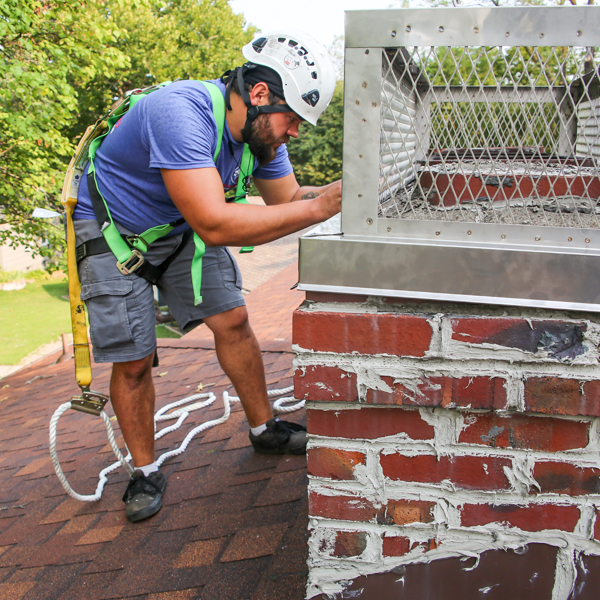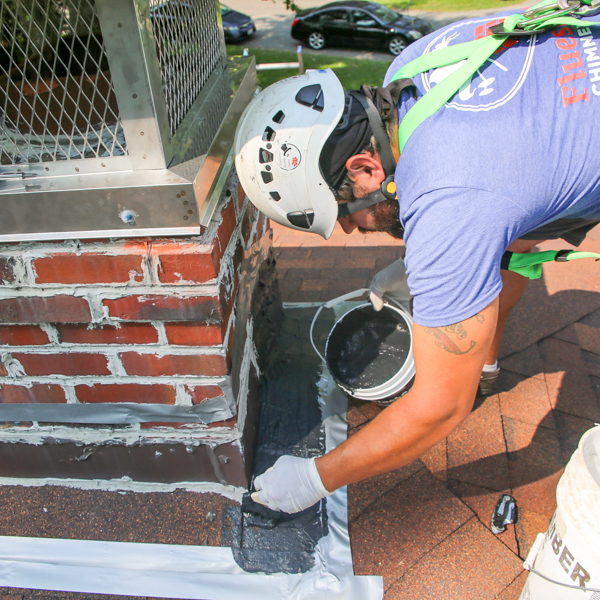Do you have any of these 7 Common Chimney Problems?
Now that the weather is turning cooler and folks in Independence, MO, and around the Kansas City Metro area are enjoying the fall colors, many are starting to prepare their fireplace for the winter season ahead. While you probably haven’t given much thought about your chimney lately, it is essential to have a chimney inspection to see if it has any of these seven common chimney problems that can lead to extensive damage and expensive repairs.
 Missing/Damaged Chimney Cap
Missing/Damaged Chimney Cap
One of the most common chimney problems is a damaged or missing chimney cap. With its location at the top of the chimney, the chimney cap takes the brunt of the weather, protecting the exposed flue from rainwater, small animals, and debris that can damage the chimney. However, continued exposure to seasonal weather conditions like high winds, freezing rain, snow, and hail can damage the chimney cap and even cause it to fall off the chimney. In addition, it exposes the flue to external elements that can lead to more extensive chimney problems and repairs.
Flue Obstruction/Small Animals
A flue obstruction is another common problem. It occurs when leaves, twigs, and debris clog the flue vent restricting the release of smoke and fumes. Also, small animals, including birds, squirrels, and other wildlife, have been known to build nests inside chimneys that can cause a flue obstruction. Also, creosote build-up in the narrow passageway of the smoke chamber and other parts of the chimney can obstruct the flue. A flue obstruction is dangerous because it can cause a backdraft, which essentially reverses the chimney draft, forcing smoke, soot, and debris out of the fireplace and into the living space exposing you to toxic carbon monoxide gas and other harmful materials.
Masonry Damage
Masonry chimneys are porous materials, and the constant exposure to freezing rain and ice can eventually cause bricks to spall and mortar to decay. As the masonry damage worsens, you may notice crumbling or missing bricks and gaps in the mortar joints. These cracks in the masonry continue to expand ultimately affecting the structure’s integrity. It also exposes the chimney to moisture intrusion that can cause severe damage to the interior masonry, flue liner, and other internal components. It also increases the fire risk, making it unsafe to use the fireplace until the masonry damage is repaired.
Creosote Build-up
Creosote build-up is a common problem that can occur without regular chimney sweeping. It is the primary cause of heating-related residential structure fires, according to the National Fire Protection Association (NFPA). Creosote is a tar-like material that is created during the combustion of wood and other fuels. At first, creosote is a white, powdery substance that is easily removed. However, it hardens into a dark, tarry, and highly flammable material that is extremely difficult to remove without regular sweeping. The high temperature of the fireplace or a hot ember can ignite the creosote and cause a chimney fire. Since many chimney fires are small, many homeowners don’t realize it occurred until a chimney inspection reveals evidence of a previous chimney fire.
Flue Liner Cracks
Flue liner cracks are common, especially if the liner is more than 15 to 20 years old. The flue liner protects the masonry and prevents the high heat in the chimney from transferring to nearby combustible building materials. However, normal wear and tear, moisture, high temperatures, and corrosive gas residue can damage the flue liner causing the clay tiles to burst or break. Therefore, it is vital to repair or replace damaged liners to meet current building codes and reduce fire risk.
Cracks in the Chimney Crown
Cracks in the chimney crown are a common source of water leaks. The chimney crown is the cement surface that tops masonry chimneys. Cracks typically occur due to age, environmental conditions, and settling. When moisture seeps through these cracks, it can cause widespread damage to the interior masonry. Replacing a damaged chimney cap or chase cover can help protect the chimney crown.
 Deteriorating Flashing
Deteriorating Flashing
The chimney flashing is a metal component that creates a water-tight seal where the chimney and roof meet. However, frequent rains, hail, snow, and improper installation can weaken the flashing making it prone to warping or corrosion. When this occurs, moisture can leak inside the chimney resulting in water stains on the ceiling and walls near the fireplace.
Annual Chimney Inspection and Cleaning in KC
The best way to avoid these and other common chimney problems is with annual chimney inspections and professional cleaning when necessary. It can also help save you thousands of dollars in chimney repairs that unresolved chimney problems can cause. Our experienced chimney technicians serve the entire KC/MO metro area. Call Fluesbrothers Chimney & Fireplace to schedule your annual chimney inspection today!
The post Do you have any of these 7 Common Chimney Problems? appeared first on Fluesbrothers Chimney Service.